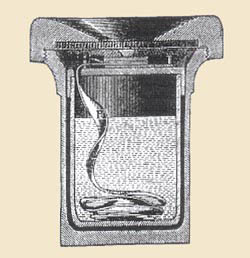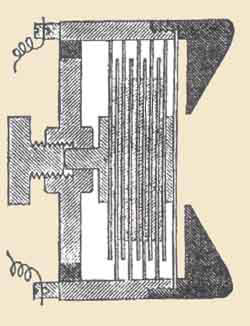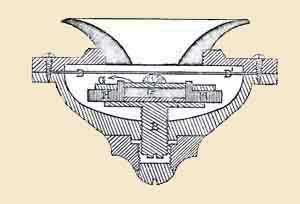The Telephones of Thomas Edison
The Telephones of Thomas Edison
 Edison is best known in telephony for the carbon transmitter that was the basis of telephone transmitters for more than a century. He experimented with many other types, one of which went into production. Edison, unlike some other researchers, documented his work thoroughly. From his notes the development of the carbon transmitter can be traced.
Edison is best known in telephony for the carbon transmitter that was the basis of telephone transmitters for more than a century. He experimented with many other types, one of which went into production. Edison, unlike some other researchers, documented his work thoroughly. From his notes the development of the carbon transmitter can be traced.
The first relevant record is a caveat filed by Edison in January 1876, prior to Bell's patent application. It shows a solenoid with the core attached to a diaphragm in a resonating chamber - a sort of loudspeaker. It could possibly be classed as a telephone of sorts, but Edison did not use it for this. He was using it for analyzing sounds, and he always gave Bell the credit for the Telephone. Considering the money involved and the number of charlatans and rogues that came forward in the later court cases, this honesty reflects well on Edison's character.
Bell arrived at the magnet, coil and diaphragm electromagnetic unit independently, and used it both as receiver and transmitter. As a transmitter it was not very good, being too faint over any great distance, and Edison was asked by Bell's competitor, the Western Union telegraph company, to invent a better one. Edison had already done successful work for Western Union on a telegraph printer, and was receiving an annual payment for this for the life of the patent. They provided him with a copy of the work of Philipp Reis, a German inventor who almost but not quite invented a workable telephone.
Reis was convinced that a if circuit could be opened and closed quickly enough by a "make or break" contact in a transmitter, the pulses produced by the broken current through a receiver could reconstitute the sound. Edison tried a transmitter based on this principle in March 1877, but ran into the same problem that Reis did. It could transmit sounds, but lost the detail of the sound when the circuit was interrupted by loud speech breaking the contact. Edison recognized the problem and tried to fix it by placing a drop of water between the contacts, then several drops, but he was never able to completely do away with the problem. The water decomposed or evaporated, then the problem returned. Emile Berliner, who was working for the Bell company, found a similar problem with his single-contact transmitter, but he put an induction coil across the transmitter and used a lower pressure on the contacts so the circuit was never entirely broken. Edison was unaware at the time of this approach, so he moved to another idea which offered more promise - variable resistance.

In June 1877 Edison tried a pot filled with carbon, with a carbon electrode at the bottom and another, the diaphragm, sitting on top. The gap between the two was filled with lampblack, a very soft form of carbon powder. Although very simple, it worked well and demonstrated that the variable resistance principle was practical. It suffered from

In an experiment in November 1877, Edison used a strip of porous paper between two electrodes, one of which was the diaphragm. The paper was kept moist by dangling it in a pot of water. It was found that the paper provided a variable resistance under pressure and, of course, did not suffer from packing. It also was not practical because it had to be mounted flat to keep the water in the pot.
In other experiments he used powdered plumbago ( galena, an ore of lead) floated on mercury with a steel diaphragm on top. Another used a small block of carbon attached by threads to a metal diaphragm. The vibration of the diaphragm changed the pressure between the carbon and the diaphragm. This was based loosely on the work of Reis, and was getting closer to the final successful carbon transmitter. Unlike Reis' Telefon, the contact did not "make and break" but relied on varying pressure, and so provided a continuous signal. It was actually too sensitive to be used in a telephone, as it also picked up all sorts of background noises. Edison also tried copper iodide, graphite, gas-carbon (a hard form of soot), felt, platinum - over 2000 substances in all.
 He developed an "Inertia telephone" which was getting closer to his goal. A small capsule of lampblack was attached rigidly to the back of the diaphragm. When the diaphragm reached the end of its travel, inertia kept the carbon powder moving, compressing it slightly. With the weight of this assembly hanging off the diaphragm, the Inertia Telephone proved too insensitive for practical use, although other inventors experimented with it later.
He developed an "Inertia telephone" which was getting closer to his goal. A small capsule of lampblack was attached rigidly to the back of the diaphragm. When the diaphragm reached the end of its travel, inertia kept the carbon powder moving, compressing it slightly. With the weight of this assembly hanging off the diaphragm, the Inertia Telephone proved too insensitive for practical use, although other inventors experimented with it later.
Edison also experimented in June 1877 with an electromagnetic transmitter, although this would have conflicted directly with Bell's patent. In this, he used a spring to damp the diaphragm for best performance, and this proved to be a valuable technique that was later used in many practical transmitters.He developed an "Inertia telephone" which was getting closer to his goal. A small capsule of lampblack was attached rigidly to the back of the diaphragm. When the diaphragm reached the end of its travel, inertia kept the carbon powder moving, compressing it slightly. With the weight of this assembly hanging off the diaphragm, the Inertia Telephone proved too insensitive for practical use, although other inventors experimented with it later.
In an interesting variation, he devised a transmitter that used a loose coil of fine wire that could be compressed slightly by the movement of the diaphragm. This shortened the coil, which was wired into the circuit as an induction coil. This gave the varying current needed. The induction telephone would have been fairly insensitive and subject to specks of dust jamming the movement of the diaphragm, and he did not persevere with the idea. In spite of this, it demonstrates Edison's wide knowledge of many physics and electronics principles, and his ability to try different approaches to a problem. He was also gathering a group of excellent technicians and machinists who could put his many theories into practice and carry out the intense testing required.

In early 1877 Edison experimented with a Condenser or Static transmitter. These rely on a charge being stored between two conductors, in this case insulated metal plates . The charge varies with the change in distance between the two plates. The early version was complex and insensitive, but in December 1877 he returned to the idea. He mounted a stack of metal plates, separated by insulating discs, behind a diaphragm. The pressure of the voice on the diaphragm varied the distance between the plates, giving the varying voltage. It would have been rather insensitive, given the weight of the plates of the condenser. This idea was later developed by other inverntors, who used a fixed back electrode and a light metal ribbon as the diaphragm, and produced a condenser microphone that found a use in broadcasting and sound recording. In the 1970s a British firm reversed the process and applied a varying voltage to the ribbon, producing high fidelity ribbon loudspeakers.
In a variation on this, Edison replaced the condenser plates with plates of copper and platinum. These were the elements of a Voltaic pile (we would call it a battery) and it generated its own voltage, which varied as the plates were put under pressure by the diaphragm. These ideas were also eventually abandoned.
A very simple telephone was devised in August 1877. It consisted of a cone and diaphragm connected to a domestic gas pipe. The diaphragm sealed off the gas, but its vibrations from the voice were transmitted through the gas and could be heard at other similar points in the house. A cheap and practical intercom, in fact.

It can be seen from these experiments that Edison was starting to deal with the problems that would haunt telephone developers for years - packing, damping, and sensitivity. The significant outcome is that he quickly abandoned the make-and-break favoured by Reis. He decided that variable resistance gave the best results in a transmitter, and carbon presented the best method of achieving this .
He worked on the carbon itself. He found that hard gas-carbon had a very high internal resistance that made it unsuitable. The best carbon was very soft, made from burning hydrocarbons like oil at the lowest temperature, generating lots of soot. The resulting soft powder could be compressed into cakes, reground, re pelletised, and finally pressed into carbon buttons that were rigid but contained the many fine contacts between the carbon grains that a sensitive transmitter needed. Provided the transmitter was designed so the carbon button remained in contact with the diaphragm, the fragile button would not be damaged.
On April 27, 1877 , Edison filed for a patent on his version of the telephone. Its claims covered two areas:
"1. In a speaking-telegraph transmitter, the combination of a metallic diaphragm and disk of plumbago or equivalent material , the contiguous faces of said disk and diaphragm being in contact, substantially as described.
2. As a means for effecting a varying surface contact in the circuit of a speaking-telegraph transmitter, the combination of two electrodes, one of plumbago or similar material, and both having broad surfaces in vibratory contact with each other, substantially as described".
This covered metal diaphragms, other diaphragms using two contacts to produce varying resistance, and all materials that could be used to make the contacts. It did not cover multiple contacts or non-metallic diaphragms and this was to cause Edison some legal problems.
Edison's immediate problem was that Emile Berliner, working for the American Bell company, had filed for a similar patent two weeks earlier. Berliner specified metallic contacts (he had been working with beads of platinum), but the Patent Office ruled that the two applications were "in interference" - they conflicted with each other. Edison did not finally get his patent until May 1892. ( He developed a dislike of the American patent system through this, and was known to contrast it unfavorably with the British system, which was faster, allowed the judges to call expert witnesses to advise them, and applied right across the country.)
In spite of this, Western Union bought his transmitter, again for an annual sum for the life of the patent. They immediately put it into production, as they were anxious to get into the telephone business themselves. Bell's telephones were cutting into their telegraph market and they wanted a piece of the action. Their telephones were sold through a new company, the American Speaking Telephone Company, and used a Phelps "Crown" receiver.


Left: ASTC telephones. The ornate piece on the right is the Phelps receiver.
Edison's production transmitter had a mica diaphragm with a carbon button attached. This pressed against the lampblack container. It was fairly simple to produce, compact and reliable. It still suffered from packing, which Edison had yet to address successfully.
The legal case between Western Union and American Bell that followed is well documented. It ended with Western Union deciding they would not win a drawn-out court case, so they settled with Bell. As part of the settlement they sold all their patents, including the rights to the Edison patent, to American Bell. Bell shelved the Edison transmitter. They were committed to their Berliner-Blake transmitter and did not have the funds to retool for another transmitter even if it was technically better. They did patent it overseas, and guarded it zealously from infringement. Some years later Henry Hunnings in Britain produced an improved version that went into production for the Bell Telephone Manufacturing Company, and eventually led to the White Solid Back transmitter that pretty much became the standard transmitter until the 1930s.

Edison saw the first great invention of his career go elsewhere. He did not appear to be too bitter about it, but it is notable that he rarely let a patent out of his control in future, preferring to set up a company to market it instead of selling it to others. As the telephone grew in popularity, he was tempted to again enter the telephone business, but he was locked out of using his own transmitter as it was now owned by Bell. He found it necessary to join forces with inventors who had patents in other countries. Britain and France were useful sources of alternative technology. In Britain, Frederic Gower had patented a carbon pencil transmitter that neatly substituted for Edison's original design. In France, Clement Ader developed a similar transmitter.
Gower's problem was the receiver. He used a large receiver coil built into the case of the phone, with two rubber tubes leading to the ears of the user. Many inventors had tried to bypass the problems of Bell's insensitive receiver by building more sensitive microphones. Gower's was one such. He produced a better transmitter using carbon pencils, as designed by Professor Hughes. Edison decided to build a new, better receiver, and join forces with Gower to market telephones in Europe.
 The new receiver was variously called the Chalk Receiver, the Motograph, or the Electromotograph. A spring loaded stylus attached to the diaphragm rested on a revolving drum of chalk. The chalk was soaked in potassium bromide, potassium iodide, or some other suitable solution. The friction between the stylus and the chalk could be varied by electrolyzing the solution. When a voltage was applied (such as from a telephone transmitter) the electrolysis of the solution reduced the friction of the stylus. This variation in friction moved the stylus and thus the diaphragm, and produced sound. The listener had to revolve the drum with a small handle all the while, although clockwork versions were developed later.
The new receiver was variously called the Chalk Receiver, the Motograph, or the Electromotograph. A spring loaded stylus attached to the diaphragm rested on a revolving drum of chalk. The chalk was soaked in potassium bromide, potassium iodide, or some other suitable solution. The friction between the stylus and the chalk could be varied by electrolyzing the solution. When a voltage was applied (such as from a telephone transmitter) the electrolysis of the solution reduced the friction of the stylus. This variation in friction moved the stylus and thus the diaphragm, and produced sound. The listener had to revolve the drum with a small handle all the while, although clockwork versions were developed later.
It worked well. It was so efficient that it was marketed as the Edison Loudspeaking Telephone. Playwright George Bernard Shaw, on using a Motograph, commented that it was "a much too ingenious invention, being nothing less than a telephone of such stentorian efficiency that it bellowed your most private communications all over the house, instead of whispering them with some sort of discretion."
Edison and Gower set up companies to market their telephones, but with the looming threat of another long legal battle with the London Bell company reason prevailed. The companies amalgamated to form the United Telephone Company. With access to all the patents, the new company standardized on Bell receivers and the new Hunnings transmitter, to which they also owned the rights. Their phones were built by a new company, Consolidated. This company also built phones of the Gower and Motograph pattern for Gower / Edison companies in Europe, in competition with local Bell companies there. In France a combination of Gower transmitters and Ader receivers appeared, and Ader transmitters with Motograph receivers. Eventually these competing companies all combined as well. This meant the end of the Motograph and Edison's involvement in telephony. He received thirty thousand pounds from Consolidated for his patent of the Motograph.
This, with the annual income from his telegraph repeater and carbon transmitter patents, left Edison well off and free to experiment in whatever areas interested him. He proceeded to fill a rich and comfortable life with invention after invention, ranging from electric light to phonographs to concrete houses. He died on October 18, 1931, a highly respected man, an American hero, and possibly the world's greatest inventor.

References:
Dyer F L and Martin T C "Edison His Life and Inventions" New York 1929
The Edison papers
http://edison.rutgers.edu
British Science and Technology Museum at http://www.ingenious.org.uk/See/Scienceandtechnology/Telecommunications/?target=SeeMedium&ObjectID=%7B4A3D2501-B4C4-8A40-9097-4F0C834F412D%7D&viewby=images
"Edison's Telephone Patents - A Rival to Bell" at http://www.connected-earth.com/Galleries/Telecommunicationsage/Thetelephone/Developingthetelephone/index.htm
BBC "The Telephone Transmitter (1877)" at http://www.bbc.co.uk/dna/h2g2/...
The Engineer "Edison's Telephonic and Acoustic Researches" Nov 29 1878. - Dec 13 1878.
Pole J "The Practical Telephone Handbook" London 1912
Bob's Old Phones at http://www.bobsoldphones.net/P...








